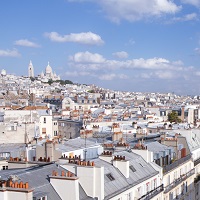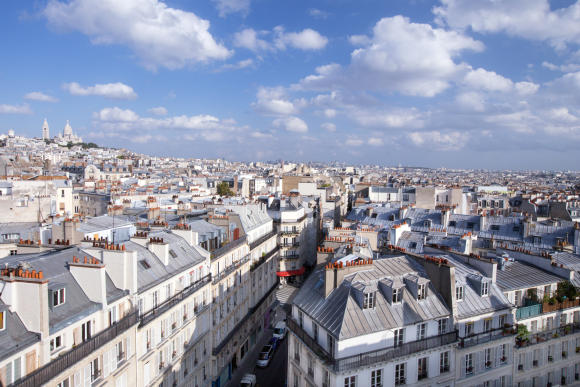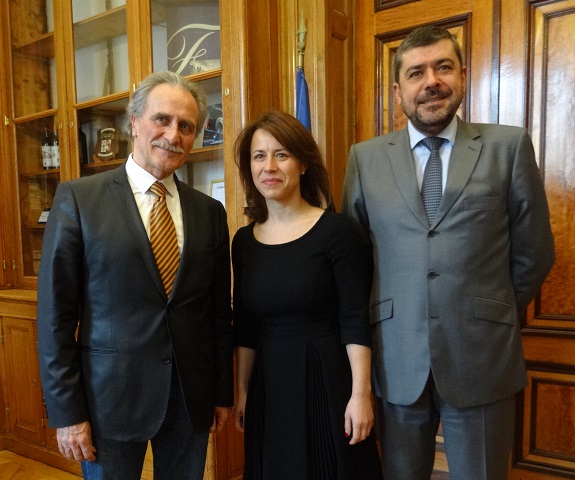
A quest for UNESCO recognition and valuable panoramas
Ah, the rooftops of Paris: the 50 shades of grey in zinc and lead, the profound blackish-blue of slate, the seductive curves of copper green, the murky nuances of red tile and the occasional sparkle of gold.
Looking out over the city from just the right height—the upper floor of the Pompidou Center, the towers of Notre-Dame, rooftop terraces, apartments on the eighth floor and above—the view is romantic for some, lusty grey for others, a commercial dream for roofers—altogether Paris.
In recent months the most attractive view over the capital has been from District Hall of the 9th arrondissement, where District Mayor Delphine Bürkli is spearheading the committee to present the rooftops of Paris as a candidate for inscription on the UNESCO World Heritage List. The Municipal Council of the City of Paris on Oct. 1, 2014 approved Bürkli’s wish to develop the candidature for UNESCO recognition, and the project was publicly launched on Feb. 5, 2015. Candidature can take several years to reach maturity.
Bürkli speaks of the rooftops of Paris as “a chef d’oeuvre of human ingenuity” and of the desire to enable Parisians to “conquer the 7th story” and buildings’ “5th façade.” (That’s the 8th floor in American parlance since the ground floor isn’t counted here.)

UNESCO lists cultural, natural and mixed sites whose cultural and/or natural heritage is considered to be “of outstanding universal value.” (Intangible cultural heritage is inscribed on another list.) The “outstanding universal value” of the rooftops of Paris is currently less clear than their economic and touristic appeal. Therefore, in addition to recognizing the historic value of the rooftops, Bürkli and the committee that’s been created to develop the UNESCO World Heritage proposal have expressed the wish to see the “underexploited” heights of Paris used for restaurants, bars, pools, vistas and gardens.
The committee claims that candidature for UNESCO listing is not an attempt to halt development and that their project is not an attempt to counter the construction of towers and skyscrapers on the edge of the city. (The latter has of late been the subject of the big tussle of Paris urbanism. The Mayor of Paris, Anne Hidalgo is very favorable to the development of vastly higher rising buildings on the inner edges of the city.)
The committee to develop the candidature for UNESCO World Heritage Listing includes Bürkli, who is a member of France’s conservative UMP party; Gilles Mermet, a journalist and photographer, author of the book “Les toits de Paris où l’art des couvreurs” (The rooftops of Paris or the roofers’ art); Alexandre Missoffe, project manager for the public transportation company Transdev; Olivier Boileau-Descamps, businessman and former political candidate (UMP), and Angel Sanchez, president of the Syndicat des Entreprises de Génie Climatique et de Couverture Plomberie, an engineering and roofing syndicate.

It can take several years to prepare candidature for UNESCO World Heritage Listing. The most significant hurdle is pre-selection by the French government for placement on UNESCO’s Tentative List, after which the final project for candidature is fleshed out before being presented to the concerned international committee. France regularly presents two items—cultural, natural or mixed—to UNESCO each year, and competition among the projects vying for pre-selection is fierce.
Indeed, an entire travel magazine, not to mention a serious school of history, politics and economics, could be devoted examining French ambitions for gaining UNESCO World Heritage Listing, so fascinating are the sites vying for “universal” recognition and so rich, complex and political is the process of forming a viable proposal.
UNESCO typically elects to list one or two properties each year at its early summer committee meeting. In 2014 the Decorated Cave of Pont-d’Arc joined the list as a cultural heritage site while Gwoka, music, song, dance and cultural practice representative of Guadeloupean identity joined as intangible cultural heritage.
France isn’t alone in Europe in its quest for UNESCO validation for their cultural heritage. Germany, Italy, Spain and the United Kingdom also run at the head of the pack, a sign of both the historical offerings of the Old World and the value of UNESCO imprimatur in the tourism industry. As an example, a 30% increase in the number of visitors to Albi Cathedral followed within two years of the listing in 2010 of the town’s Episcopal City (of which the cathedral is the centerpiece). Of course, it wasn’t simply the listing that did this but also efforts to showcase and promote the cathedral. The two naturally go hand in hand.
Heritage—whether local, regional, national or “universal”—goes well beyond showcasing a specific site. It involves wider territorial notions of heritage, the political and economic considerations of preservation and, most visibly, all of the issues associated with tourism and development around the given site. Sites (often a series of sites brought together under a common theme of heritage) covering large and diverse the territory naturally raise complex questions.
Current examples of such large and diverse territories on UNESCO’s Tentative List are the Funerary Sites and Memorials of the First World War on the Western Front (in France and Belgium) and the Landing Beaches of Normandy of the Second World War. Those sites were preselected by France to join the Tentative List in 2014. The full project of each candidature may not be complete for examination to the international committee until 2017.
© 2015, Gary Lee Kraut

